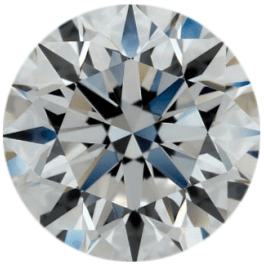

Sign up to begin your Journey with a MOH

Fluorescence in diamonds is caused by the occurrence of a certain particle in particular diamonds which emits a powerful shine (mostly blue) that can be observed upon exposure of the diamond gem to UV rays. Diamond stones with strong fluorescence capabilities have a whitish glow (dull-like) when seen under sunlight. Generally fluorescence does not determine how sparkly or beautiful a diamond will be, especially for lower colours (I, J, K, L and others). Historically, diamonds with no fluorescence were perceived to be more pure; but this ideology has sparked argument numerous times amongst the diamond lovers and specialists over the years. In actuality, diamonds with no fluorescence or with very low fluorescence capabilities have natural appearance, but with more brilliance when seen in UV light or in ordinary sunlight.
It is important to understand that the structural integrity of a diamond is not affected by fluorescence. The presence of natural elements in the diamond that cause fluorescence do not weaken the binding of hardened carbon.

No fluorescence, no influence on colour. No soft, blue glow is emitted when the diamond is exposed to UV light. The diamond has no trace elements that cause fluorescence. None fluorescence has the largest premium and is highly desired and expensive. These diamonds are regarded as ‘purer’
A slight soft, blow glow is noticed when the diamond is exposed to UV light. The diamond has minor trace elements that cause fluorescence. There is no impact on the diamond. None and Faint fluorescence have an almost identical effect on a diamond’s value.


A light blue glow is emitted by a diamond, when exposed to UV light. It can improve the colour of lower grades such as J, K or L.
The diamonds with strong fluorescence can be beneficial to lower colours J,K or L again it can have a negative effect on high colour diamonds such as D, E, which can look slightly greyish or hazy.


Diamond fluorescence has little to no effect on a diamond’s sparkle, and research shows that it doesn’t impact beauty either. A very bright blue glow is present when the diamond is exposed to UV light. The diamond’s appearance may be effected. Very Strong fluorescence can make a diamond look grey or hazy.
The perception and value accorded to fluorescent diamonds have evolved over the years. Before the age of diamond certification, ‘blue white’ diamonds were the most sought after by a lot of merchants in Europe. Later in the 1970s, diamonds with a very concentrated blue fluorescent (colour grade D with strong blue fluorescent and low transparency) started being devalued due to the milky or ‘hazy effect.” In the following years, even colour F diamonds and those with weaker fluorescence began to lose value and their prices reduced significantly.
Although most people associate fluorescence with the blue colour in diamonds, one-third of diamonds that fluoresce also exude yellow, green and even white colours. Fluoresce in diamonds does not generally affect their appearance. As a result, most diamond laboratories use this quality to identify the characteristics of the diamond as opposed to using it for grading. Nonetheless, more diamond specialists are using diamond fluorescence as a price setter. The appearance of colourless and almost-colourless diamonds is negatively affected by fluorescence, thus leading to the decrease in the value and price of these diamonds by most laboratories.
According to societal standards, fluorescent diamonds are sometimes given better color grades than what they should have by some GIA labs because of their false appearance through the small UV radiation in GIA lab lights. However, there are cases where fluorescent diamonds are seen as very beautiful by the human eye and hence the argument that fluorescent diamond colour grading should be done under natural lighting arrives.
Although the presence or absence of fluorescence does not determine the overall outlook of a diamond, this variable is still used in grading. The range of fluorescence goes from faint, medium, strong to very strong, with the last two depicting an opaque cloudy colour that reduces their shine and transparency. According to GIA Gem Trade Laboratory standards, the concentration of fluorescence in diamonds is not a direct indicator of the final colour or clarity of the gem when observed table-down, although non-industry diamond lovers reported that they found strong fluorescent diamond jewelry to have a more appealing colour when observed table-up
Diamonds are naturally formed gems at 75 to 125 miles under the surface of the earth, a space associated with volcanic rocks. There are several processes that occur for the rocks to become diamond, amongst them is crystallisation by carbon. Fluorescence occurs during the process of diamond crystallisation, and is caused by the presence of boron particles at that particular time.
About 10% of all diamonds are said to fluoresce strong enough to be noticed by the human eye in natural lighting, although almost 50% of all diamonds have an amount of fluorescent that can be seen under special lighting. The most common fluorescent colour for diamonds is blue, although there are other colours like white, orange, green, and yellow.
For ages, non-fluorescent diamonds have been viewed as purer and fetching higher prices than fluorescent diamonds. Thus, the most expensive fluorescence diamonds are the ones with faded to medium colour (lower colour I-N) that exude immense beauty in all lights.
In very rare cases, fluorescence will make a diamond appear hazy, milky or oily and thus fluorescence in diamonds will not generally deter its beauty. If you cannot decide on what type of diamond to buy because of the colour or the influence of fluorescence, consult our diamond specialist to suggest you the best choice.